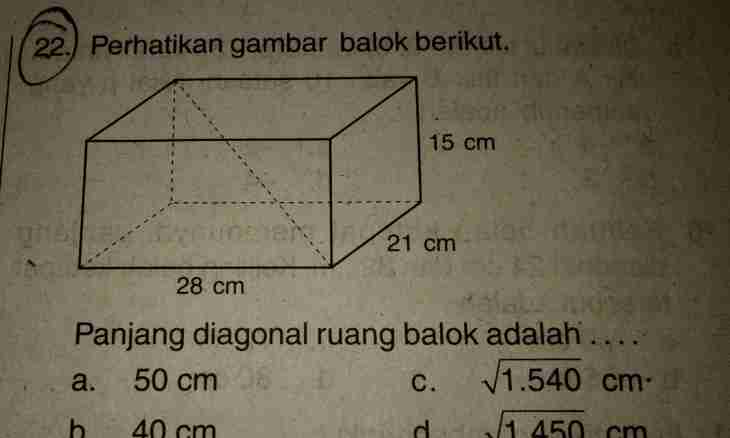Parallelepiped – the many-sided geometrical figure having several interesting properties. Knowledge of these properties helps with the solution of tasks. There is, for example, a certain communication between its linear and diagonal measurements by means of which it is possible to find lengths of edges of a parallelepiped on diagonal.
Instruction
1. The parallelepiped has one feature not peculiar to other figures. Its sides are in pairs parallel and have equal measurements and numerical characteristics, such as area and perimeter. Any couple of such sides can be taken for the bases, then remained will make its side surface.
2. It is possible to find lengths of edges of a parallelepiped on diagonal, however one this size is not enough. First, pay attention to that, what version of this spatial figure is given you. It can be the correct parallelepiped possessing right angles and equal measurements i.e. a cube. In this case will enough know length of one diagonal. In all other cases there have to be, at least, one more known parameters.
3. Diagonals and lengths of the parties in a parallelepiped are connected by a certain ratio. This formula follows from the theorem of cosines and represents equality of the sum of squares of diagonals and the sum of squares of edges: d1² + d2² + d3² + d4² = 4 • and² + 4•b² + 4 • with², where and – length, b – width and with - height.
4. For a cube the formula becomes simpler: 4 · d² = 12 • and² and = d / √ 3.
5. Example: to find length of the party of a cube if its diagonal is equal to 5 cm. Decision.25 = 3 • and²а = 5 / √ 3.
6. Let's consider a direct parallelepiped at which side edges are perpendicular to the bases, and the bases are parallelograms. Its diagonals are in pairs equal and connected with lengths of edges by the following principle: d1² = and² + b² + with² + 2 • and • b · cos α; d2² = and² + b² +c² – 2 • and • b · cos α, where α – an acute angle between the parties of the basis.
7. This formula can use if are known, for example, one of the parties and a corner or these sizes can be found on other statements of the problem. The decision becomes simpler when all corners in the basis straight lines, then: d1² + d2² = 2 • and² + 2•b² + 2 • with².
8. Example: find width and height of a rectangular parallelepiped if width of b is more than length and on 1 cm, height with – is twice more, and d diagonal – in 3. Decision. Write down a basic formula of a square of diagonal (they are equal in a rectangular parallelepiped): d² = and² + b² + with².
9. Express all measurements through the set length and: b = and + 1; c = and • 2; d = and • 3. Substitute in a formula: 9 · and² = and² + (and + 1)² + 4 • and²
10. Solve a quadratic equation: 3 · and² – 2 • and – 1 = 0naydite lengths of all edges: and = 1; b = 2; c = 2.

